1995 OLDSMOBILE SILHOUETTE weight
[x] Cancel search: weightPage 212 of 390
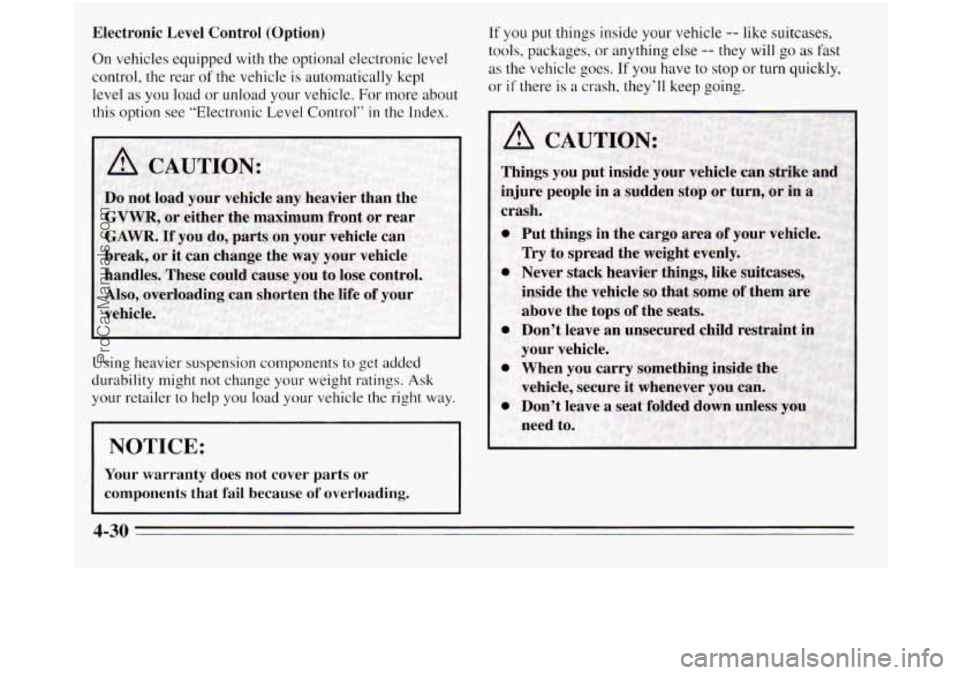
Electronic Level Control (Option)
On vehicles equipped with the optional electronic level
control, the rear
of the vehicle is automatically kept
level as
you load or unload your vehicle. For more about
this option see “Electronic Level Control”
in the Index.
Using heavier suspension components to get added
durability might not change your weight ratings.
Ask
your retailer to help you load your vehicle the right way.
NOTICE:
Your warranty does not cover parts or
components that fail because of overloading.
If you put things inside your vehicle -- like suitcases,
tools, packages, or anything else
-- they will go as fast
as the vehicle goes. If you have to stop or turn quickly,
or
if there is a crash, they’ll keep going.
4-30
ProCarManuals.com
Page 213 of 390
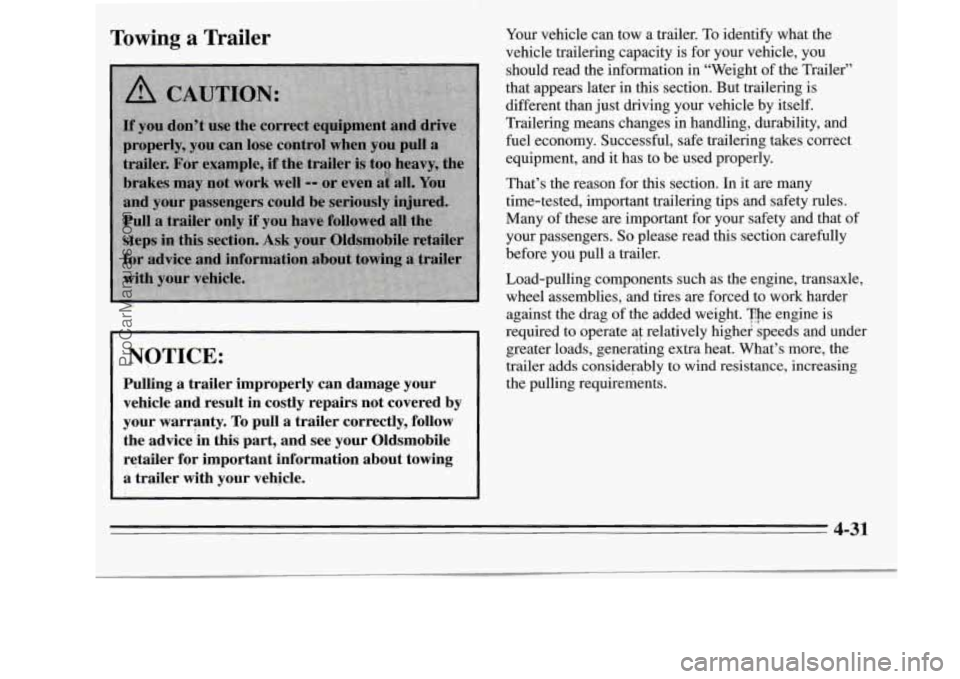
Towing a Trailer
NOTICE:
Pulling a trailer improperly can damage your vehicle and’result in costly repairs not covered by
your warranty.
To pull a trailer correctly, follow
the advice‘in this part, and see your Oldsmobile
retailer for important information about towing a trailer with your vehicle.
Your vehicle can tow a trailer. To identify what the
vehicle trailering capacity is for your vehicle, you
should read the information in “Weight of the Trailer”
that appears later in this section. But trailering is
different than just driving your vehicle by itself.
Trailering means changes in handling, durability, and
fuel economy. Successful, safe trailering takes correct
equipment, and it has to be used properly.
That’s the reason for this section. In it are many
time-tested, important trailering tips and safety rules.
Many of these are important for your safety and that of
your passengers.
So please read this section carefully
before you pull a trailer.
Load-pulling components such as the engine, transaxle,
wheel assemblies, and tires are forced to work harder
against the drag of the added weight. The engine is
required
‘to operate ai relatively highei speeds and under
greater loads, generating extra heat. What’s more, the
trailer adds considerably to wind resistance, increasing
the pulling requirements.
4-31
ProCarManuals.com
Page 214 of 390
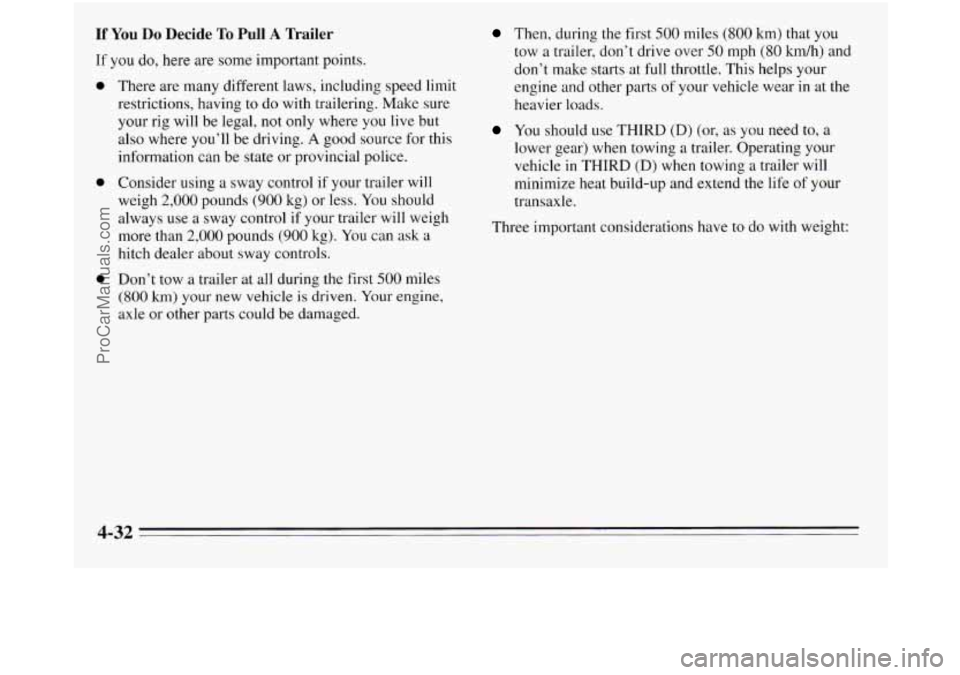
If You Do Decide To Pull A Trailer
If you do, here are some important points.
a
a
0
There are many different laws, including speed limit
restrictions, having to do with trailering. Make sure
your rig will be legal, not only where you live but
also where you’ll be driving.
A good source for this
information can be state or provincial police.
Consider using a sway control if your trailer will
weigh
2,000 pounds (900 kg) or less. You should
always use a sway control if your trailer will weigh
more than
2,000 pounds (900 kg). You can ask a
hitch dealer about sway controls.
Don’t tow a trailer at all during the first
500 miles
(800 km) your new vehicle is driven. Your engine,
axle or other Parts could be damaged.
Then, during the first 500 miles (800 km) that you
tow a trailer, don’t drive over
50 mph (80 ludh) and
don’t make starts at full throttle. This helps your
engine and other parts of your vehicle wear in at the
heavier loads.
You should use THIRD (D) (or, as you need to, a
lower gear) when towing a trailer. Operating your
vehicle
in THIRD (D) when towing a trailer will
minimize heat build-up and extend the life of your
transaxle.
Three important considerations have to
do with weight:
4-32
ProCarManuals.com
Page 215 of 390
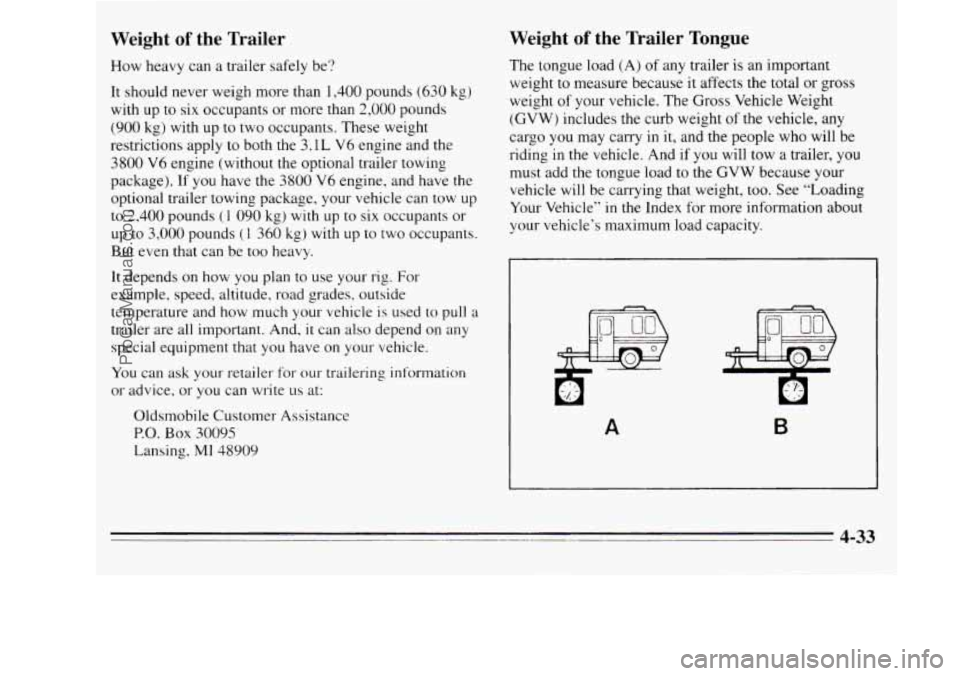
Weight of the Trailer
How heavy can a trailer safely be?
It should never weigh more than 1,400 pounds (630 kg)
with up to six occupants or more than 2,000 pounds
(900 kg) with up to two occupants. These weight
restrictions apply to both the
3.1L V6 engine and the
3800 V6 engine (without the optional trailer towing
package).
If you have the 3800 V6 engine, and have the
optional trailer towing package, your vehicle can tow up
to 2,400 pounds
(I 090 kg) with up to six occupants or
up
to 3,000 pounds (1 360 kg) with up to two occupants.
But even that can be too heavy.
It depends on how you plan to use your rig. For
example, speed, altitude, road grades, outside
temperature and how much your vehicle is used to pull
a
trailer are all important. And, it can also depend on any
special equipment that
you have on your vehicle.
You can ask your retailer for our trailering information
or advice, or
you can write us at:
Oldsmobile Customer Assistance
P.O. Box 30095
Lansing,
MI 48909
Weight of the Trailer Tongue
The tongue load (A) of any trailer is an important
weight to measure because it affects the total
or gross
weight
of your vehicle. The Gross Vehicle Weight
(GVW) includes the curb weight of the vehicle, any
cargo you may carry
in it, and the people who will be
riding in the vehicle. And
if you will tow a trailer, you
must add the tongue load to the GVW because your
vehicle will be carrying that weight,
too. See “Loading
Your Vehicle” in the Index for more information about
your vehicle’s maximum load capacity.
A B
4-33
ProCarManuals.com
Page 216 of 390

If you’re using a “dead-weight” hitch, the trailer tongue
(A) should weigh 10% of the total loaded trailer weight
(B). If you have a “weight-distributing” hitch, the trailer
tongue (A) should weigh
12% of the total loaded trailer
weight (B).
After you’ve loaded your trailer, weigh the trailer and
then the tongue, separately, to see if the weights are
proper. If they aren’t, you may be able to get them right
simply by moving some items around in the trailer.
Total Weight on Your Vehicle’s Tires
Be sure your vehicle’s tires are inflated to the limit for
cold tires. You’ll find these numbers on the
CertificatiordTire label at the rear edge of the driver’s
door or see “Tire Loading” in the Index.
Then be sure
you don’t go over the GVW limit for your vehicle,
including the weight of the trailer tongue.
Hitches
It’s important to have the correct hitch equipment.
Crosswinds, large trucks going by, and rough roads are a
few reasons why you’ll need the right hitch. Here are
some rules to follow:
0 If you’ll be pulling a trailer that, when loaded, will
weigh more than
2,000 pounds (900 kg), be sure to
use a properly mounted, weight-distributing hitch
and sway control
of the proper size. This equipment
is very important for proper vehicle loading and
good handling when you’re driving.
Will you have to make any holes in the body of your
vehicle when you install a trailer hitch?
If you do,
then be sure to seal the holes later when you remove
the hitch. If you don’t seal them, deadly carbon
monoxide
(CO) from your exhaust can get into your
vehicle (see “Carbon Monoxide” in the Index). Dirt
and water can, too.
0 The bumpers on your vehicle are not intended for
hitches.
Do not attach rental hitches or other
bumper-type hitches to them. Use only a
frame-mounted hitch that does not attach to
the
bumper.
4-34
ProCarManuals.com
Page 218 of 390
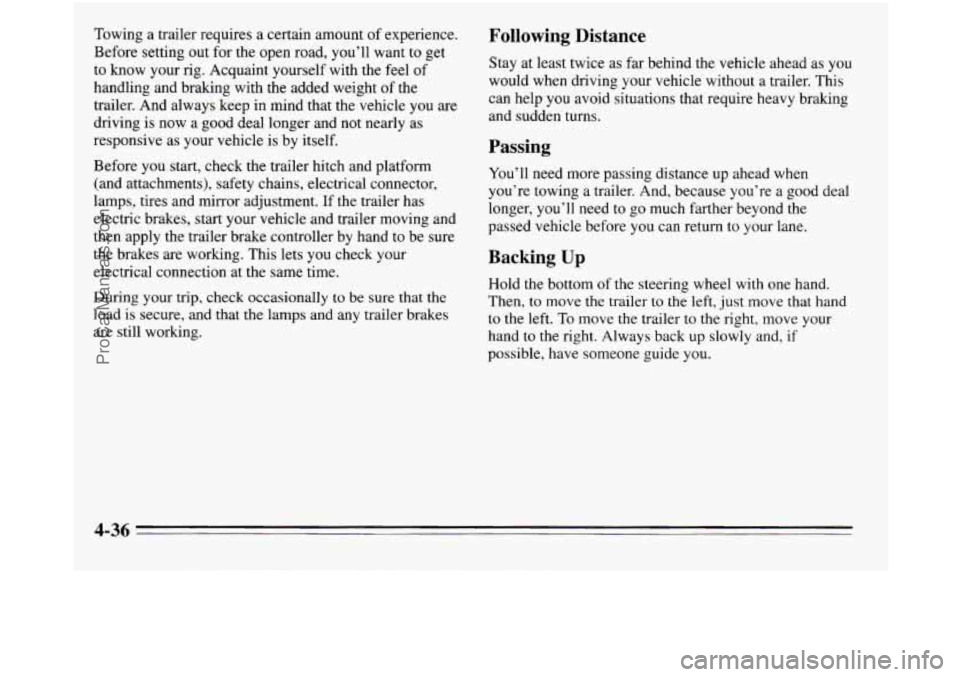
Towing a trailer requires a certain amount of experience.
Before setting out for the open road, you’ll want
to get
to know your rig. Acquaint yourself with the feel of
handling and braking with the added weight of the
trailer. And always keep in mind that the vehicle
you are
driving is now a good deal longer and not nearly as
responsive as your vehicle is by itself.
Before you start, check the trailer hitch and platform
(and attachments), safety chains, electrical connector,
lamps, tires and mirror adjustment. If the trailer has
electric brakes, start your vehicle and trailer moving and
then apply the trailer brake controller by hand to be sure
the brakes are working. This lets you check your
electrical connection at the same time.
During your trip, check occasionally
to be sure that the
load is secure, and that the lamps and any trailer brakes
are still working.
Following Distance
Stay at least twice as far behind the vehicle ahead as you
would when driving your vehicle without a trailer. This
can help you avoid situations that require heavy braking
and sudden turns.
Passing
You’ll need more passing distance up ahead when
you’re towing a trailer. And, because you’re a good deal
longer, you’ll need to go much farther beyond the
passed vehicle before you can return to your lane.
Backing Up
Hold the bottom of the steering wheel with one hand.
Then, to move the trailer
to the left, just move that hand
to the left. To move the trailer
to the right, move your
hand to the right. Always back
up slowly and, if
possible, have someone guide you.
4-36
ProCarManuals.com
Page 381 of 390

Engineoil .................................... 6-11
adding
..................... : .............. 6-12
Additives
................................... 6-16
Checking
................................... 6-11
What Kind to Use
............................ 6- 13
What to do with Used Oil
...................... 6-16
. Whentochange ............................. 6-16
Ethanol
(In Fuel) ................................ 6-3
Expectarit Mothers, Use
of Safety Belts ............. 1-31
Extender, Safety Belt
....................... : .... 1-57
Fabric: Cleaning
.......................... : .... 6-42
Filling Your Tank
................................ 6-4
Filter Aircleaner
................................. 6- 17
Engine
Oil .................................. 6-16
Finishcare
.................................... 6-47
Fihish Damage
............................ : .... 6-48
First
Gear (1) Position ............ ; .............. 2-32
Flashers, Hazard Warning
......................... 5-1
Flat Tire, Changing
............................. 5-24
FogLamps
.................................... 2-50
Foreign Countries, Fuel
........ : .................. 6-4
ForwardGears
................................. 2-30
FrontDoors
.................................... 2-3
Front Towing Ifbokups
.......................... 5- 11
Fuel
.......................... i............... 6-2
FillingYourTank
............................. 6-4
Gage
...................................... 2-86
In Foreign Countries ........................... 6-4 Fuse
Paiiel(3.lL V6 Engine)
............ ......... 6-53
Fuse Panel (3800 V6 Engine) ..................... 6-54
Fuses and Circuit Breakers
....................... 6-52
Gag&. Engine Coolant Temperature
............... 2-80
Garage
Door Opener Compartment.
Overhead Console
.............................. 2-5 1.
Gasolines for Cleaner Air .......................... 6-3
GAWR (Gross Axle Weight Rating)
................ 4-29
Gear Positions
................................. 2-28
Glass. Cleaning
................................ 6-46
GloveBox .................................... 2-21
GVWR (Gross Vehicle Weight Rating)
.............. 4-29
Halogen Bulbs
................................ 6-31
Hazqd Warning Flashers
.......................... 5-1
Head Restraints ................................. 1-4
Headlamp High-Low Beam Changer
............... 2-50
Headlamp. Wiring
.............................. 6-57
Headlamps
.................................... 2-49
Headlamps. Bulb Replacement
.................... 6-31
Hearing or Speech Impaired. Customer Assistance
...... 8-2
High Beam
Lamps. How to Change ................ 2-50
Highway Hypnosis
........................ ; ..... 4-22
HillandMountainRoads
......................... 4-23
Hitches. Trailer
i ................................ 4-34
HoodProp
..................................... 6-7
HoodRelease
................................... 6-6
9-5
ProCarManuals.com
Page 387 of 390
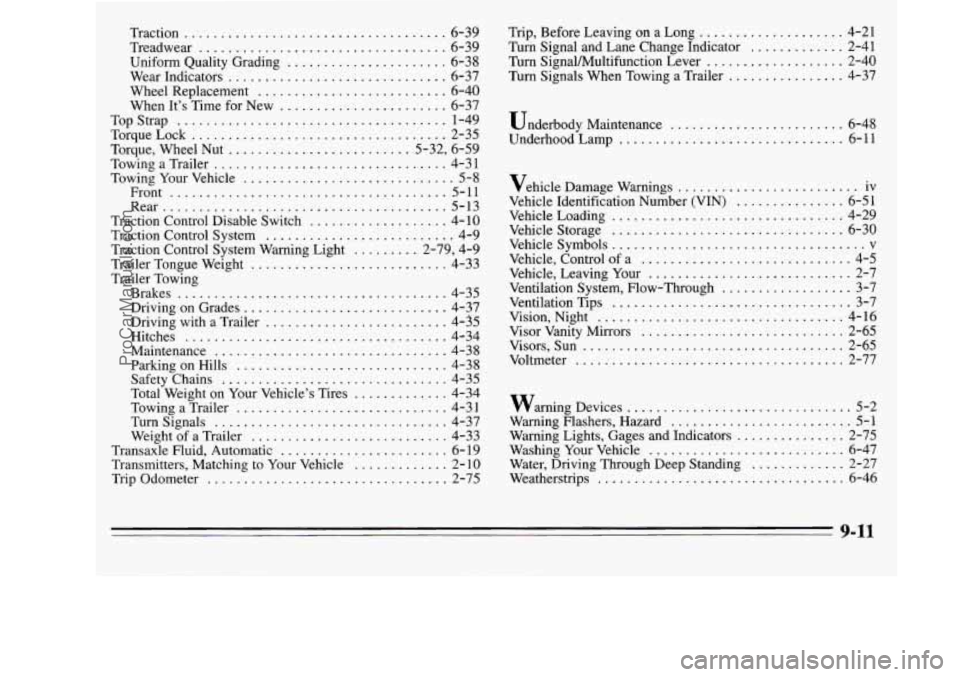
Traction .................................... 6-39
Treadwear
.................................. 6-39
Uniform Quality Grading
...................... 6-38
Wear Indicators
.............................. 6-37
Wheel Replacement
.......................... 6-40
When It’s Time for New
....................... 6-37
Top Strap
..................................... 1-49
TorqueLock
................................... 2-35
Torque. Wheel
Nut ......................... 5.32. 6.59
Towing a Trailer
................................ 4-3 1
Towing Your Vehicle ............................. 5-8
Front ...................................... 5-11
Rear
....................................... 5- 13
Traction Control Disable Switch
................... 4-10
Traction Control System
.......................... 4-9
Traction Control System Warning Light
......... 2-79, 4-9
Trailer Tongue Weight
........................... 4-33
Trailer Towing Brakes
..................................... 4-35
Driving on Grades
............................ 4-37
Driving with a Trailer
......................... 4-35
Hitches
.................................... 4-34
Maintenance
................................ 4-38
Parking on Hills
............................. 4-38
Safety Chains
............................... 4-35
Total Weight on Your Vehicle’s Tires
............. 4-34
Towing
a Trailer ............................. 4-31
Turnsignals
................................ 4-37
Transaxle Fluid, Automatic
....................... 6- 19
Transmitters, Matching to Your Vehicle
............. 2- 10
Trip Odometer
................................. 2-75
Weight
of a
Trailer ........................... 4-33 Trip. Before Leaving on a Long
.................... 4-21
Turn Signal and Lane Change Indicator
............. 2-41
Turn SignaVMultifunction Lever
................... 2-40
Turn Signals When Towing a Trailer
................ 4-37
Underbody Maintenance
........................ 6-48
Underhood Lamp
............................... 6-11
Vehicle Damage Warnings
......................... iv
Vehicle Identification Number (VIN)
............... 6-51
Vehicle Loading ................................ 4-29
Vehicle Storage
........................ : ....... 6-30
Vehicle Symbols
................................... v
Vehicle. Control of a ............................. 4-5
Vehicle. Leaving Your
............................ 2-7
Ventilation Tips
................................. 3-7
Vision. Night
.................................. 4-16
Visor Vanity Mirrors
............................ 2-65
Visors. Sun
.................................... 2-65
Voltmeter ..................................... 2-77
Ventilation System. Flow-Through
.................. 3-7
warning Devices
............................... 5-2
Warning Flashers. Hazard
......................... 5-1
Warning Lights. Gages and Indicators
............... 2-75
Washing Your Vehicle
........................... 6-47
Water. Driving Through Deep Standing
............. 2-27
Weatherstrips .................................. 6-46
9-11
ProCarManuals.com